Come utilizzare la funzione di ricerca di Microsoft Excel
_ In questo articolo impareremo come usare la funzione RICERCA in Microsoft Excel._
_La funzione RICERCA MS-Excel restituisce la posizione del primo carattere della sottostringa o del testo_ricerca in una stringa. La funzione non distingue tra lettere maiuscole e minuscole durante la ricerca. A differenza di TROVA, RICERCA consente caratteri jolly, come il punto interrogativo (?) E l’asterisco (). Il punto interrogativo (?) Corrisponde a qualsiasi carattere singolo e l’asterisco () corrisponde a qualsiasi sequenza di caratteri.
Tuttavia, nel caso in cui desideriamo trovare un vero punto interrogativo (?) O un asterisco (*), digitiamo una marea (~) prima del carattere. Se la sottostringa non viene trovata all’interno della stringa, la funzione restituirà l’errore #VALUE.
La funzione SEARCH può essere utilizzata come potente funzione di metodo stringa se combinata con la funzione MID ._
Gli argomenti / sintassi della funzione sono:
 We have dummy data in column A. Column B contains the text which we will search for. And column C has the starting position of the search. And, here in column D, we will enter the SEARCH function.
We have dummy data in column A. Column B contains the text which we will search for. And column C has the starting position of the search. And, here in column D, we will enter the SEARCH function.
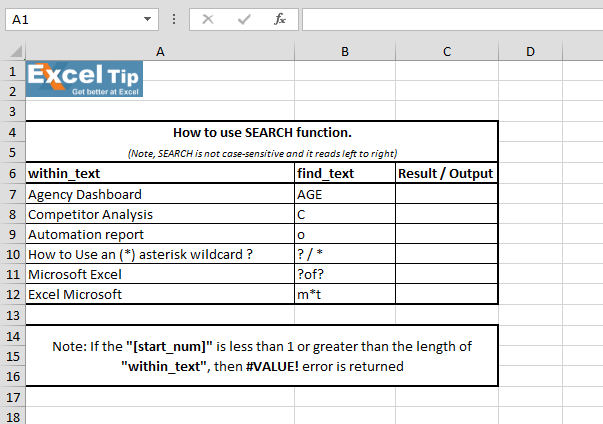 1st Example:- In the first example, we will search “AGE” in cell A7.
1st Example:- In the first example, we will search “AGE” in cell A7.
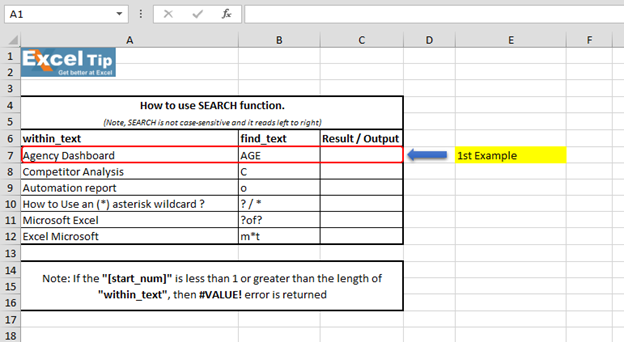 Follow the steps given below:- Enter the function in cell C7 =SEARCH(“AGE”,A7,1)
Follow the steps given below:- Enter the function in cell C7 =SEARCH(“AGE”,A7,1)
-
Premi Invio
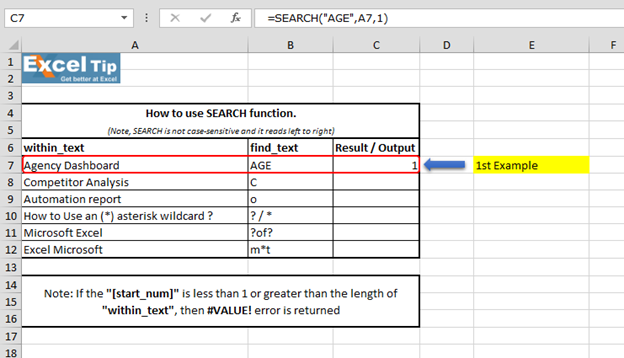 It returns to 1 because “SEARCH” is looking from the first character, and it found AGE beginning from the 1st character. So it gives us 1 here. 2nd Example:- In this example, we will search for “C” and we give the starting number as zero or negative number as the starting position.
It returns to 1 because “SEARCH” is looking from the first character, and it found AGE beginning from the 1st character. So it gives us 1 here. 2nd Example:- In this example, we will search for “C” and we give the starting number as zero or negative number as the starting position.
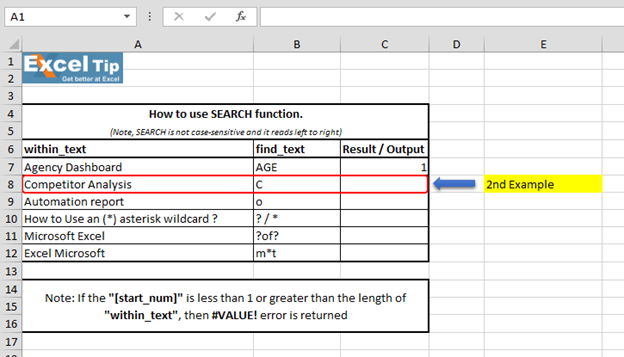 Follow the steps given below:- Enter the function in cell C8 =SEARCH(“c”,A8,-1), Press Enter
Follow the steps given below:- Enter the function in cell C8 =SEARCH(“c”,A8,-1), Press Enter
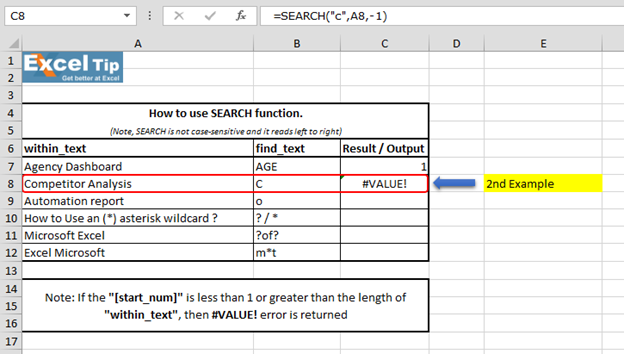 The Function has returned #VALUE error because neither negative nor 0 can be the starting position. 3rd Example:- In this example, we will show you what if we have to find the text which is there multiple times in the string.
The Function has returned #VALUE error because neither negative nor 0 can be the starting position. 3rd Example:- In this example, we will show you what if we have to find the text which is there multiple times in the string.
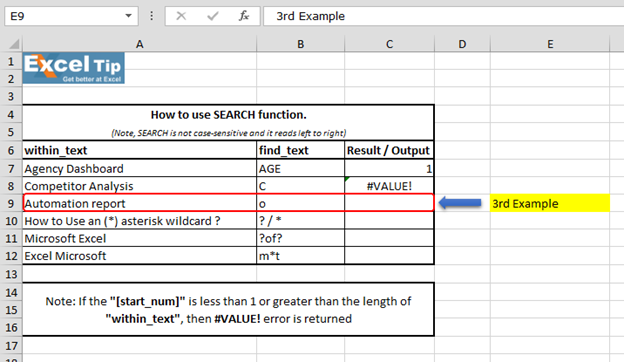 Follow the steps given below:- Enter the function in cell C9 =SEARCH(“o”,A9,5), Press Enter
Follow the steps given below:- Enter the function in cell C9 =SEARCH(“o”,A9,5), Press Enter
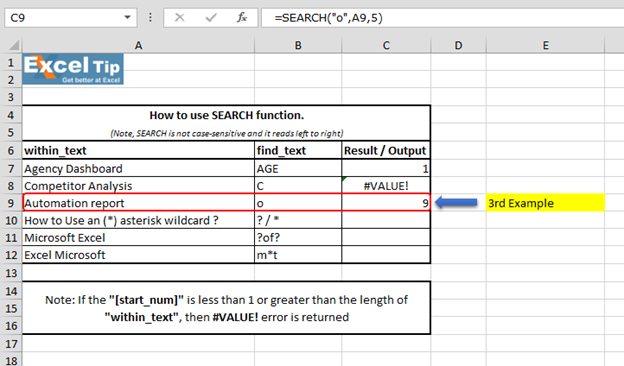 The function has ignored the “o” which is at 4th position and the function returns to 9 as the position. Because it ignored the first “o” and started looking from 5th character onwards.
The function has ignored the “o” which is at 4th position and the function returns to 9 as the position. Because it ignored the first “o” and started looking from 5th character onwards.
Tuttavia, restituisce la posizione complessiva della stringa. 4 ^ ^ Esempio: – In questo esempio, cercheremo la posizione dei caratteri jolly all’interno della cella A10.
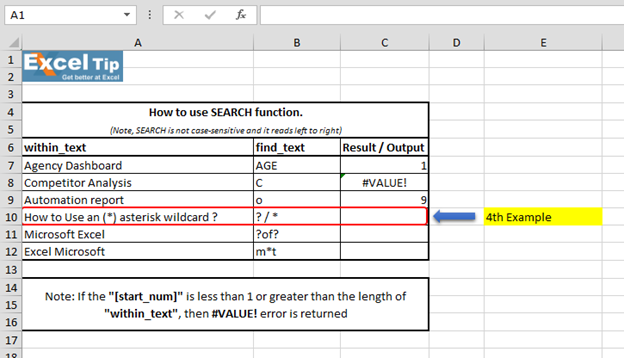 Follow the steps given below:- First we’ll look for () asterisk sign, enter the function in cell C10 =SEARCH(“”,A10,1), Press Enter
Follow the steps given below:- First we’ll look for () asterisk sign, enter the function in cell C10 =SEARCH(“”,A10,1), Press Enter
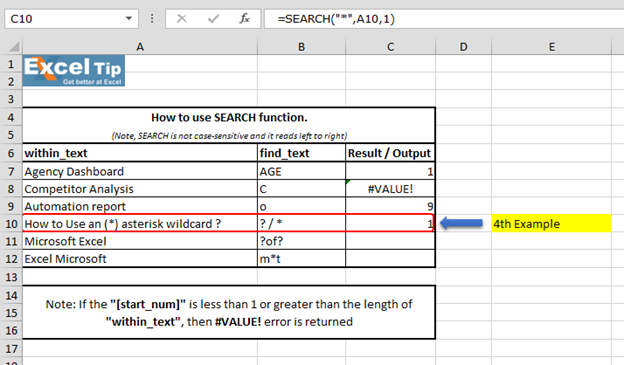 The function has returned 1, because we cannot find any wildcard without using tilde. As we use tilde (~) as a marker to indicate that the next character is a literal, we will insert (~) tilde before (*) asterisk.
The function has returned 1, because we cannot find any wildcard without using tilde. As we use tilde (~) as a marker to indicate that the next character is a literal, we will insert (~) tilde before (*) asterisk.
Immettere questa funzione = SEARCH (“~”, A10,1)
-
Ora restituisce 16 come posizione
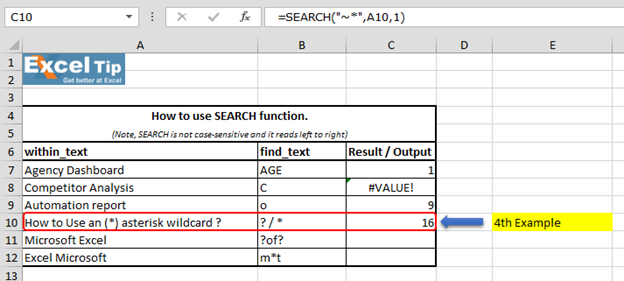 We can also look for question mark:- Enter the function in same cell C10 =SEARCH(“~?”,A10,1), Press Enter
We can also look for question mark:- Enter the function in same cell C10 =SEARCH(“~?”,A10,1), Press Enter
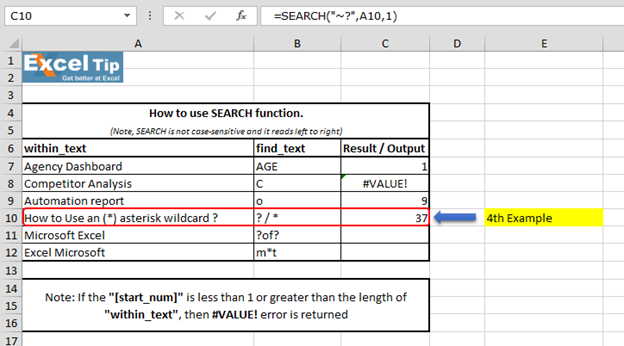 We can see that function gave us “37” as the position of (?) question mark. 5th Example:- In this example, we’ll learn how to enter SEARCH function to search “?of?”.
We can see that function gave us “37” as the position of (?) question mark. 5th Example:- In this example, we’ll learn how to enter SEARCH function to search “?of?”.
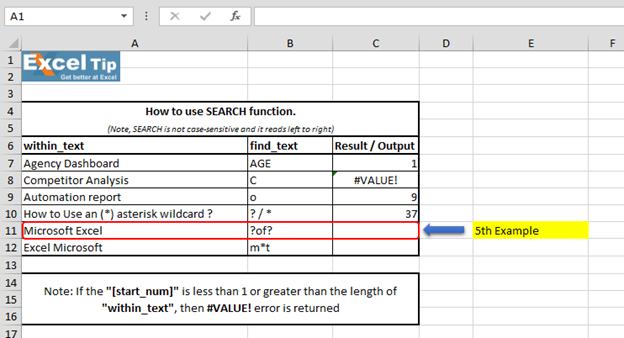 Follow the steps given below:- Enter the function in cell C11 =SEARCH(“?of?”,A11,1)
Follow the steps given below:- Enter the function in cell C11 =SEARCH(“?of?”,A11,1)
-
Premi Invio
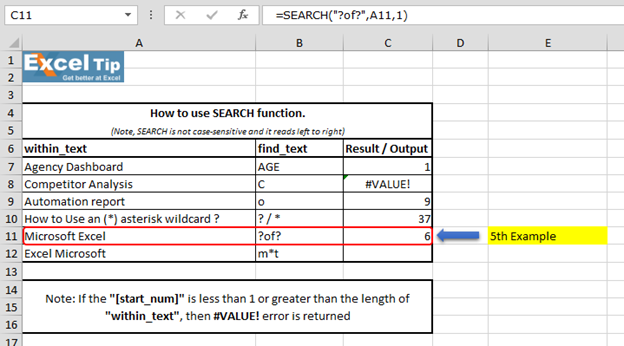 We scan to see that function has returned 6 because it matches “soft” which is present in the mid of “Microsoft Excel” string and hence the value is 6. Note:- (?) question mark wildcard denotes any single character. 6th Example:- In this example, we’ll learn another use of wildcard in SEARCH function.
We scan to see that function has returned 6 because it matches “soft” which is present in the mid of “Microsoft Excel” string and hence the value is 6. Note:- (?) question mark wildcard denotes any single character. 6th Example:- In this example, we’ll learn another use of wildcard in SEARCH function.
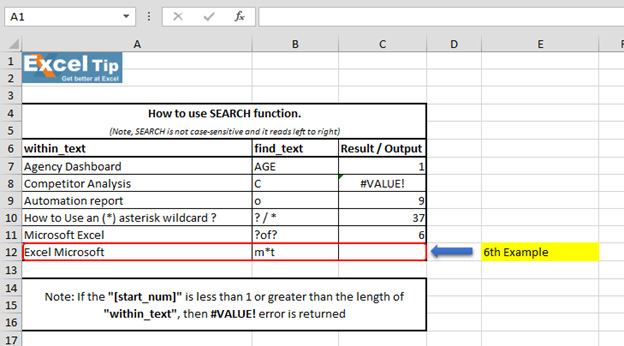 Follow the steps given below:- Enter the function in cell C12 =SEARCH(“m*t”,A12,1)
Follow the steps given below:- Enter the function in cell C12 =SEARCH(“m*t”,A12,1)
Nota: – Nel primo argomento, diciamo alla funzione di cercare la stringa che inizia con “m” e finisce con “t”, inserendo l’asterisco (*) in mezzo.
-
Premi Invio
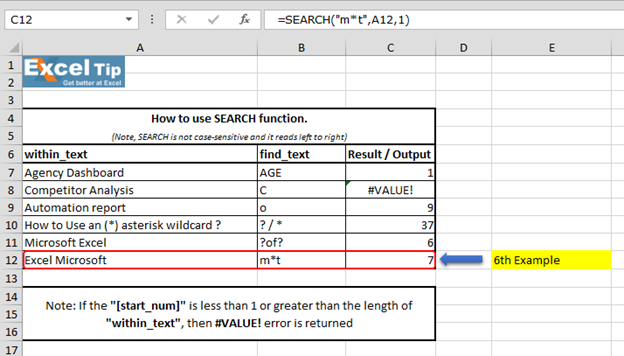 “Microsoft Excel” and it finds there is a string which starts with “M” and ends with “L”. No matter how many characters are there in between and hence it returns 1. Because (*)
“Microsoft Excel” and it finds there is a string which starts with “M” and ends with “L”. No matter how many characters are there in between and hence it returns 1. Because (*)
il carattere jolly asterisco corrisponde a qualsiasi sequenza di caratteri. Quindi, questo è il modo in cui funziona la funzione RICERCA in situazioni diverse.
Video: come utilizzare la funzione RICERCA in Microsoft Excel Fare clic sul collegamento video per un riferimento rapido all’uso della funzione RICERCA. Iscriviti al nostro nuovo canale e continua ad imparare con noi!
https://www.youtube.com/watch?v=HW0QP1JxeuU Se ti sono piaciuti i nostri blog, condividilo con i tuoi amici su Facebook. Puoi anche seguirci su Twitter e Facebook. _ Ci piacerebbe sentire la tua opinione, facci sapere come possiamo migliorare, integrare o innovare il nostro lavoro e renderlo migliore per te. Scrivici a [email protected]_